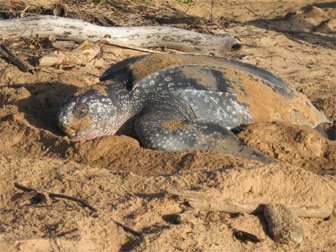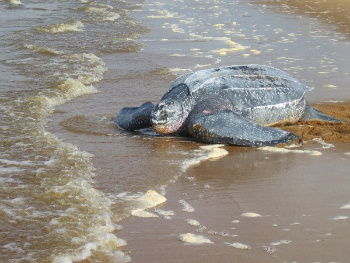Costa Rica is considered by many to be a shining example of environmental stewardship, preserving both its terrestrial and marine biodiversity while benefiting from being a popular tourist location. However, a new move by the Costa Rican government has placed their reputation in question.
In May of this year the President of Costa Rica, Oscar Arias, presented a law to the legislature that would downgrade Las Baulas from a National Park to a ‘mixed property wildlife refuge’. The downgrading would authorize a number of development projects that conservationists say would threaten the park’s starring resident: the leatherback turtle. The world’s largest sea turtle, the leatherback, is classified as Critically Endangered by the IUCN Red List, and Las Baulas National Park is considered a vital nesting ground for the Pacific population.
“This new law introduced by President Arias will be the death of the Costa Rican National Park System and the protection it provides to your environmental national treasures. The world has looked-up to Costa Rica as an example of how to shape an ecotouristic economy; yet this action by the Arias administration will open Pandora’s box to the elimination and attacks on all the other national parks,” marine biologist Frank Paladino of Indiana University-Purdue University Fort Wayne stated in a letter.
 Leatherback sea turtle laying eggs on a beach in Suriname. Photo by Tiffany Roufs. |
The law if passed would reduce protected area along the beaches where leatherbacks nest from 120 meters to 50. It would further allow a wide-variety of development, including condominiums and tourist facilities. Conservationists say that such developments would bring a flood of people, vehicles, and domestic animals that will harm the leatherback habitat.
“[The Leatherback sea turtle] Pacific population is in great trouble due mainly to beach disturbance. They have declined by about 98 percent since the early 1980s. Former large nesting populations in Mexico are a tiny fraction of earlier numbers. In the west Pacific, the leatherback turtle’s largest population has apparently gone extinct in the last few years,” explains President and co-founder of the Blue Ocean Institute, Carl Safina. “These creatures, and the world, need Costa Rica to do what it can to protect the remaining Pacific leatherbacks and promote their recovery. And so little is required. All that is needed is darkness on the beach at night and protection of nests. The beach at Las Baulas Park that is currently without houses should remain so, and the Park should be reaffirmed by Costa Rica’s Congress.”
On hatching sea turtles head toward the lightest area on the horizon, which in a natural environment is the ocean. Electric lights often lead turtle hatchlings astray, sometimes causing heavy mortality among baby sea turtles.
The government has stated that its reasoning for downgrading the park is that it is too expensive to purchase the land set aside for the park. Yet conservationists attest that the government estimates for purchasing park land are grossly inflated and that the Costa Rican government has several means at its disposal to acquire the land.
 Leatherback sea turtle returning to the ocean after laying eggs on a beach in Suriname. Photo by Tiffany Roufs. |
“I think the important thing here is that it would be very easy to acquire the land within Las Baulas park if the government had a one dollar a night tax on hotel rooms and one dollar a day tax on rental cars. That would raise at least 10 million a year, a conservative estimate, and a 30-year bond could be done to raise 300 million that could be used to reimburse all landowners in all parks and have an endowment for the parks into the future. What is missing is the political will in the government,” offered Jim Spotila, president of Leatherback Trust.
In addition, conservationists say that the President’s proposal to downgrade the park violates numerous agreements it has signed including Peace with Nature; the International Sea Turtle Convention; the Convention on Biological Diversity Biological; as well as the Convention for the Protection of Flora, Fauna and Natural Scenic Beauty of the Americas.
Nature Air’s blog, together with other sources, was used for information for this article. This blog continues to track the situation.
Related articles
Scientists find world’s largest leatherback sea turtle population in Gabon

(05/17/2009) Scientists have found the world’s largest population of nesting leatherback sea turtles. On the beaches of Gabon in West Africa land and air surveys estimated the small country’s leatherback population to be between 15,730 and 41,373 individual females. The findings are published in Biological Conservation. Leatherback sea turtles are currently considered critically endangered by the IUCN, however these new numbers may cause marine biologists to reconsider that ranking.
Plastic garbage accounts for one-third of leatherback sea turtle mortalities
(03/17/2009) A new study in Marine Pollution Bulletin has confirmed that the world’s largest sea turtle is succumbing in startling numbers to an environmental issue that receives little attention: plastic trash in the oceans.

(01/27/2009) After a year studying marine biology at Moss Landing Marine Labs, Liz McHuron headed off to the little-known nation of Suriname to monitor leatherback sea turtles. Her responsibilities included implementing a conservation strategy for a particular beach, moving leatherback nests in danger of flooding, and educating volunteer workers on the biology, behavior, and conservation efforts of the world’s largest, and most unique, marine turtle. I visited McHuron during her time at the beach of Galibi in Suriname; she proved to be the sort of scientist who refused to be deterred: breathtaking humidity or downpours, fer-de-lances on the beach or jaguars, Liz was always on the move, always working to aid the critically-endangered leatherbacks while studying them with the thoroughness inherit in a born scientist.